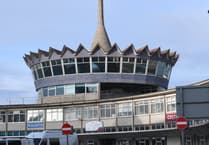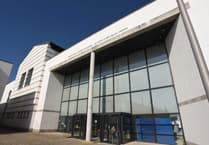The Isle of Man has a fantastic opportunity to lead the way in the field of renewable energy.
That is the view of green experts from across the island who came together to share their thoughts on what a sustainable future could look like.
The roundtable event, hosted by the Capital International Group at its offices in Douglas, was organised by the Energy Sustainability Centre (ESC) in partnership with the Isle of Man Marketing and Communications Agency (MMC) and Media Isle of Man.
The session was an opportunity for pioneers driving change in their own contexts to team up with experts for a lengthy conversation about the challenges facing the Isle of Man and work being done to drive the sustainability agenda.
Among those who took part in the discussion were ESC director Ralph Peake, Capital International Group co-founder and chairman Anthony Long, Zurich International’s chief operating officer Mark Cady, Orsted’s Isle of Man development director John Galloway, the Isle of Man’s former senior meteorological officer Adrian Cowin and Manx Wildlife Trust chief executive officer Leigh Morris.
One of the topics which came to the forefront during the debate was energy security - an issue which many western countries have been grappling with since the Russia’s invasion of Ukraine in 2022.
The move led to a dramatic increase in domestic energy and fuel prices across the world amid renewed hostilities between Russia - the world’s second largest exporter of oil and one of the biggest producers of natural gas - and the west. But Ralph Peake, business director at the Isle of Man’s ESC, says the island possesses all the right ingredients to ‘grow’ its own energy.
‘We have an abundance of natural resources here in the Isle of Man,’ he said, highlighting the island’s unique opportunity to capitalise on wind power.
‘Because we're in the middle of the Irish Sea, the wind actually comes across to the Isle of Man and it's not then weakened by going across lands.
‘So we really do have that powerful wind and we can then harness that into renewable energy.
.jpg?width=752&height=500&crop=752:500)
‘We can store the energy that's been harnessed from the wind as well as from solar, we get quite good hours of sunlight in the island.
‘If we can actually generate that energy and store it in a way that we can then use it for our own needs going forward, it would mean an absolutely fantastic future in terms of green energy for the island and would make [the island] an attractive place for people to come and live and working on.’
It’s a view that Mr Galloway, Isle of Man development director for renewable energy company Ørsted, wholeheartedly agrees with.
Back in 2015, his Danish employer was awarded an exclusive licence by Isle of Man Government to try and develop the island’s first offshore windfarm.
Plans for that scheme, known as the Mooir Vannin project, have now been drawn up and are currently subject to an island-wide public consultation.
If given the go-ahead, it would see up to 100 wind turbines erected between six and 12 nautical miles in the sea off Maughold.
Back in 2022, the Isle of Man Government published its first Climate Change Plan.
Spanning a period of five years, the 38-page document outlines the actions that the government needs to take to keep the island on track to transition to net zero by 2050, a pledge broadly agreed by a total of 197 countries under the 2015 Paris climate agreement in a bid to limit global temperature rises.
The plan outlines the government’s targets for reducing emissions in six policy areas, including energy, transport and agriculture.
And for Mr Galloway, acknowledging and capitalising on the Isle of Man’s renewable energy opportunities would be critical.
.JPG?width=752&height=500&crop=752:500)
‘The Isle of Man is effectively coming to the end of the first phase of electricity generation of its existing assets,’ he said.
‘So you have the gas power station [at Pulrose], we still have the old diesel stock power station over in Peel.
‘And the reality is those are going to come to the end of their life whether we like it or not.
‘There has to be a next step in order for the Isle of Man to be energy secure.
‘That decision now comes at a time when the rest of the world is on a transformation both in offshore wind, what we do and what we do around the world.
‘What we're proposing with the Mooir Vannin project is to take a long-term view for the next 35 years, the lifetime of a wind farm, and harness that [energy generation opportunity], bringing power to the island that will create security and energy independence.
‘Obviously in our [Ørsted’s] case, we have an opportunity to export [energy] to the UK to power well over a million homes in the UK equivalent.
‘That would brin in revenue and benefits [to the island] through the agreement we have with the Isle of Man Government.’
Away from the potential of harnessing and selling the island’s energy, Mr Galloway believes that renewables also have the ability to transform the island’s fortunes for the better.
‘The general impression that you get no matter where you go around the UK or around Ireland or around the world when it comes to what these types of [renewable energy] projects do is that they transform communities for the future industries that are coming,’ he said.
‘Whether it's through the supply chain, or whether it's through direct jobs, wind turbine technicians, commercial jobs, environmental experts, there are people now working in this as a global industry as if it is a global industrial revolution.
‘The chance that the Isle of Man’s got because it's got to make this decision is that it can seize all the opportunities from around the world, bring them here and potentially be a very good net exporter of green energy.’
And according to experience meteorologist Adrian Cowin, this tipping point in the future of energy generation in the Isle of Man could help it blaze a trail that other nations could follow.
.JPG?trim=0,0,0,0&width=752&height=501&crop=752:501)
After working 40 years at the Isle of Man’s Met Office, becoming its senior meteorological officer until he retired last summer, Mr Cowin is now a Director at the ESC.
He thinks the Isle of Man can ‘shine as an example’ for similar island nations.
‘Sustainability is not just about power and renewable power, it’s recruiting and retaining specialists, staff, technologies and engineering and all the support mechanisms that go with that.
‘That includes administration, legal frameworks and policies and so you end up having that circle of off compliance that only the Isle of Man can provide because it's got that set of people and skills been developed over quite a long time.
‘But that's a shining example of the opportunities that the Isle of Man can have with our specialist population, a population that can become even more specialist and shown as a benchmark to other small islands as a sustainable way forward.
‘That seems very powerful to me and going down that route as soon as possible is a win win as far as I can see.’
But what of the potential impact of the offshore windfarm on the Isle of Man’s unique nature, wildlife and environment?
Manx Wildlife Trust chief executive officer Leigh Morris took a pragmatic view on the situation.
.JPG?width=752&height=500&crop=752:500)
‘Any development has an impact on nature but Manx Wildlife Trust are 100% [of the belief] that the island needs renewable energy,’ he said.
‘We need energy to live, we need to get it somewhere and we think renewable energy is the way to do it.
‘We want the right renewables in the right place so we've done some due diligence on Ørsted.
‘I've met with colleagues from Yorkshire and Lincolnshire Wildlife Trust, the CEOs there that have been working with Ørsted for a long time ,and frankly, they give Ørsted a fantastic reference and there's huge biodiversity net gain projects [in these areas].
‘We know Ørsted are a company that is making money but they're ethically making money on something which we support.
‘The really good this is to hear that in the Isle of Man, because we're an independent nation, we've got the opportunity to do it differently.
‘So we're nudging Ørsted in a good way because we're saying we want our wind farm to do great things for biodiversity, but we want our offshore windfarm to blow the others away.
‘We want this [Mooir Vannin] to be the best ever wind farm that's ever been built in terms of biodiversity.
‘And maybe there's barriers to this, perhaps there’s people wiser than me out there who will say that this might not be possible but we want our wind farm to be exemplar and I want our government to be saying the same thing to Ørsted because then we work with the right partner who knows exactly how to build a wind farm, but we nudge them a bit to make ours the best in the world in terms of what biodiversity can look like.’
Watch the video above for a taste of the discussion or see below to watch the full playlist of videos from the debate.




Comments
This article has no comments yet. Be the first to leave a comment.